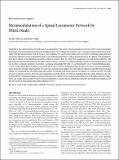Files in this item
Metamodulation of a spinal locomotor network by nitric oxide
Item metadata
| dc.contributor.author | McLean, DL | |
| dc.contributor.author | Sillar, Keith Thomas | |
| dc.date.accessioned | 2010-12-03T16:57:09Z | |
| dc.date.available | 2010-12-03T16:57:10Z | |
| dc.date.issued | 2004-10-27 | |
| dc.identifier | 329458 | |
| dc.identifier | ced4db5b-cb1b-47dc-bc9a-38588ad776e0 | |
| dc.identifier | 000224749600011 | |
| dc.identifier | 7444226816 | |
| dc.identifier.citation | McLean , DL & Sillar , K T 2004 , ' Metamodulation of a spinal locomotor network by nitric oxide ' , The Journal of Neuroscience , vol. 24 , no. 43 , pp. 9561-9571 . https://doi.org/10.1523/JNEUROSCI.1817-04.2004 | en |
| dc.identifier.issn | 0270-6474 | |
| dc.identifier.other | ORCID: /0000-0003-0171-3814/work/64393763 | |
| dc.identifier.uri | https://hdl.handle.net/10023/1622 | |
| dc.description.abstract | Flexibility in the output of spinal networks can be accomplished by the actions of neuromodulators; however, little is known about how the process of neuromodulation itself may be modulated. Here we investigate the potential "meta"-modulatory hierarchy between nitric oxide (NO) and noradrenaline (NA) in Xenopus laevis tadpoles. NO and NA have similar effects on fictive swimming; both potentiate glycinergic inhibition to slow swimming frequency and GABAergic inhibition to reduce episode durations. In addition, both modulators have direct effects on the membrane properties of motor neurons. Here we report that antagonism of noradrenergic pathways with phentolamine dramatically influences the effect of the NO donor S-nitroso-N-acetylpenicillamine (SNAP) on swimming frequency, but not its effect on episode durations. In contrast, scavenging extracellular NO with 2-(4-carboxyphenyl)-4,4,5,5-tetramethylimidazoline-1-oxyl-3-oxide(PTIO) does not influence any of the effects of NA on fictive swimming. These data place NO above NA in the metamodulatory hierarchy, strongly suggesting that NO works via a noradrenergic pathway to control glycine release but directly promotes GABA release. We confirmed this possibility using intracellular recordings from motor neurons. In support of a natural role for NO in the Xenopus locomotor network, PTIO not only antagonized all of the effects of SNAP on swimming but also, when applied on its own, modulated both swimming frequency and episode durations in addition to the underlying glycinergic and GABAergic pathways. Collectively, our results illustrate that NO and NA have parallel effects on motor neuron membrane properties and GABAergic inhibition, but that NO serially metamodulates glycinergic inhibition via NA. | |
| dc.format.extent | 11 | |
| dc.format.extent | 748665 | |
| dc.language.iso | eng | |
| dc.relation.ispartof | The Journal of Neuroscience | en |
| dc.subject | Nnitric oxide | en |
| dc.subject | Noradrenaline | en |
| dc.subject | Inhibition | en |
| dc.subject | Brainstem | en |
| dc.subject | Spinal cord | en |
| dc.subject | Locomotion | en |
| dc.subject | Xenopus laevis | en |
| dc.subject | Xenopus-laevis tadpoles | en |
| dc.subject | Central-nervous-system | en |
| dc.subject | Mediated synaptic potentials | en |
| dc.subject | Hatchling frog tadpoles | en |
| dc.subject | Inhibitory synapses | en |
| dc.subject | Stopping response | en |
| dc.subject | Pattern generator | en |
| dc.subject | Neural activity | en |
| dc.subject | Motor behavior | en |
| dc.subject | In-vitro | en |
| dc.subject | QP Physiology | en |
| dc.subject.lcc | QP | en |
| dc.title | Metamodulation of a spinal locomotor network by nitric oxide | en |
| dc.type | Journal article | en |
| dc.contributor.institution | University of St Andrews. School of Psychology and Neuroscience | en |
| dc.identifier.doi | 10.1523/JNEUROSCI.1817-04.2004 | |
| dc.description.status | Peer reviewed | en |
| dc.identifier.url | http://www.scopus.com/inward/record.url?scp=7444226816&partnerID=8YFLogxK | en |
This item appears in the following Collection(s)
Items in the St Andrews Research Repository are protected by copyright, with all rights reserved, unless otherwise indicated.

